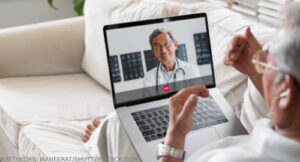 Does the Research Match Providers’ Gut Feelings about Remote Care?
Does the Research Match Providers’ Gut Feelings about Remote Care?
EULAR 2024 (VIENNA)—The number of rheumatology patients is increasing, and the number of rheumatology providers is decreasing. Wait times for new and follow-up appointments are long, especially in rural areas. In short, access to care is and will continue to be a pressing issue. Using telehealth for follow-up and self-management interventions is one possible way to mitigate these issues. In fact, the use of telehealth during the COVID-19 pandemic could be seen as a proof-of-concept test, leading to increased use and social acceptability of remote care.
But is this change good? What do the data show?
At EULAR 2024, three experts engaged the audience in a lively discussion framed by personal experiences and available evidence. Additional commentary from Annette De Thurah, PhD, professor, Department of Clinical Medicine, Section of Rheumatology, Aarhus University, Denmark, is included below.
Remote Care
Remote care uses digital technologies (i.e., telehealth interventions) when the patient and provider are not in the same place. This approach includes communication before and after appointments, live video encounters, electronic disease monitoring and screening—sometimes via third-party apps.1

Dr. De Thurah
Remote care has become an increasingly active area of research, and Dr. De Thurah and colleagues published a paper in 2022 that highlights considerations for the “development, prioritization and implementation of remote care and telehealth for people with rheumatic and musculoskeletal diseases.”1
Ask the Audience, Ask the Expert
This EULAR session had a unique conversational and convivial format. The audience was polled for their gut feeling on four different questions, followed by evidence-supported conversations with the experts.
Question 1: Is remote rehabilitation provided through digital solutions as effective as face-to-face rehabilitation?
About half of the audience felt that remote rehabilitation services, such as physical therapy, were as effective as face-to-face sessions and half did not.
“Remote rehabilitation has been shown to be as effective as in-person approaches,” said Dr. De Thurah. “This [area] is actually where we have the most data, and studies keep coming in. The quality of evidence is moderate to strong within all the studies. The outcome in these studies varies strongly, but overall, they’re mostly in favor of telehealth interventions.”2,3
Some advantages of remote rehabilitation include better communication between providers and patients, greater accessibility, increased patient comfort and safety in their home environments, and patient empowerment and self-management.
The experts did address the risk of bias in these studies, which at first glance didn’t appear favorable. Only 30% of the studies had a low risk of bias, 23% had a medium risk and 47% had a high risk.
“If these studies were for a new medication, would you take this drug?” the experts asked. An audience member made the astute point that if the studies with a low risk of bias were large, randomized controlled trials, then yes, he would.
Dr. De Thurah said, “We can’t blind the intervention in [studies that examine remote vs. face-to-face care], so there will always be some selection bias. But there’s so much evidence pointing in the same direction here that yes, I’d take that drug too. … Results depend on the quality of the study. We know these interventions must be developed based on participatory design in close collaboration with all relevant stakeholders.”
Question 2: Does remote care contribute to inequity?
The overwhelming majority of the audience responded with yes, and the experts agreed.
Remote care may not be equally accessible to all patients due to differences in internet access and tech savvy. The language the patient speaks matters, too. One expert noted that more than 85% of health apps are developed in English. Thus, non-English speakers and others with difficulty communicating in English have problems using these tools.
Another important consideration is app development. Who the app developer is plays an important role in designing the product that will best serve users. Take Whitney Wolfe Herd, the founder of the dating app Bumble, for example. She left Tinder to create a dating app that was more female friendly. She is now the world’s youngest, self-made female billionaire.
The experts stressed the importance of including end users (patients) in the app development process. Simply put, if we want to create apps that a diverse array of patients can use, we need to include a diverse array of patients in the creation process. Involving stakeholders is one of the best ways to combat inequity.
Question 3: Does shared decision making between patient & health professionals work in remote care?
Two-thirds of the audience thought that shared decision making worked during remote care, and one-third felt it didn’t. The experts’ answer: The jury is still out.
A 2022 systematic review of the literature on shared decision making through telemedicine included only 12 studies, none of which focused on patients with rheumatic and musculoskeletal diseases. Further, none of these studies tested the effects of remote care on shared decision making. They were mostly qualitative.4
Moving forward, the experts favored “digitally supported shared decision making.” They envisioned using technology to collect data and discuss those findings with patients.
Question 4: Is a remote care solution efficient for increasing communication & collaboration within the multidisciplinary team?
Most of the audience said yes. However, many feared that remote care may increase the workload of healthcare professionals.
An expert noted it is currently increasing workload because we haven’t been trained on how to use digital tools properly, and a lot of companies are in the middle. Better training may help address this concern down the line.
Final Words
Dr. De Thurah concluded the presentation with a powerful message. “It’s not easy to implement remote care into daily clinical practice,” she said. “It takes legacy and leadership. We all need to agree that this [change] is the right direction, otherwise it’s impossible.”
She also advocated for a shifting resources and energy away from the development of remote care tools and toward their implementation. “Something works in a study, but does it really work in real life?” she asked. “We need to move on from developing new apps to investigating who these [apps] are for and who they aren’t for.”
Last, Dr. De Thurah spoke about the importance of being intentional with data collection. “If we don’t use the data the patients send us, they’ll stop sending it. But I don’t think it’s healthy for patients to measure, measure, measure. There’s such a thing as too much data. We need to jointly decide with our patients what we’ll measure and how often,” she said.
Samantha C. Shapiro, MD, is the executive editor of Harrison’s Principles of Internal Medicine. As a clinician educator, she practices telerheumatology and writes for both medical and lay audiences.
References
- De Thurah A, Bosch P, Marques A, et al. 2022 EULAR points to consider for remote care in rheumatic and musculoskeletal diseases. Ann Rheum Dis. 2022;81(8):1065–1071.
- Molina-Garcia P, Mora-Traverso M, Prieto-Moreno R, et al. Effectiveness and cost-effectiveness of telerehabilitation for musculoskeletal disorders: A systematic review and meta-analysis. Ann Phys Rehabil Med. 2024 Feb;67(1):101791.
- Withers HG, Glinsky JV, Chu J, et al. Remotely delivered physiotherapy is as effective as face-to-face physiotherapy for musculoskeletal conditions (REFORM): A randomised trial. J Physiother. 2024 Apr;70(2):124–133.
- Hartasanchez SA, Heen AF, Kunneman M, et al. Remote shared decision making through telemedicine: A systematic review of the literature. Patient Educ Couns. 2022;105(2):356–365.



